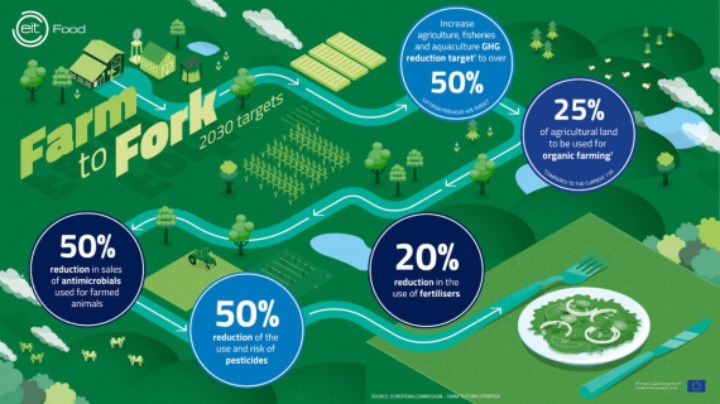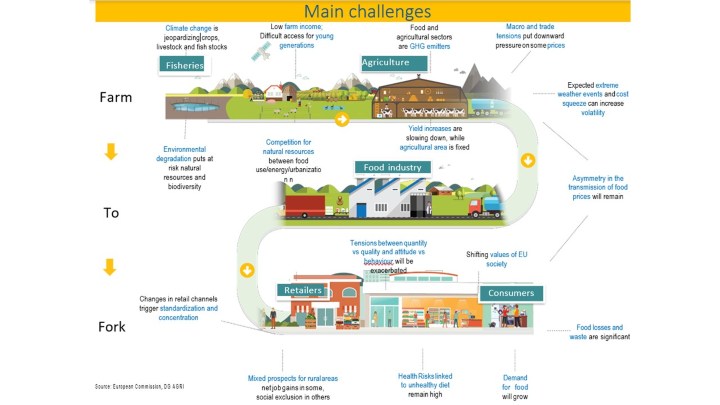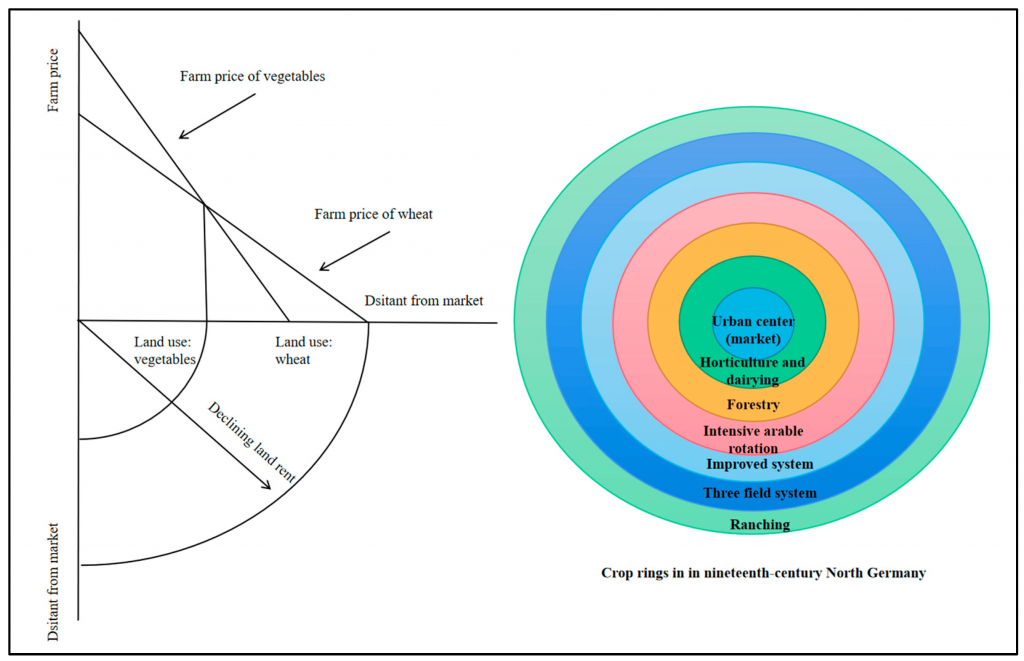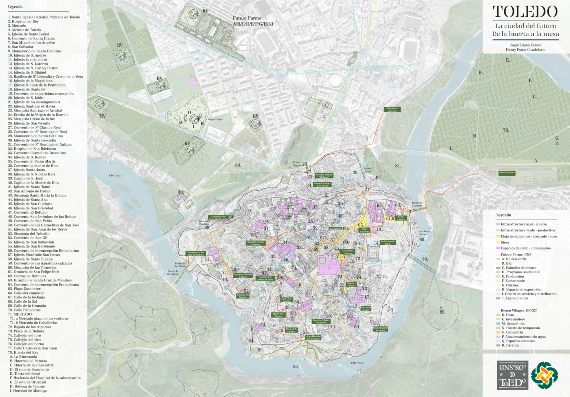The development of humanity, the origins of civilization, and the creation of both culture and cities run parallel to our food.
The shift from a rural economy based on agriculture and trade to an urban, industrialized and automated economy (with exponential growth) represents the largest set of economic, technological and social transformations in the history of humanity since Neolithic times. As Johann Heinrich Von Thünen explains the theory in The Isolated State, up until the Industrial Revolution, the location of agricultural activities was determined by the cost of transporting food to the market, which defined the territory as a concentric organization for the production of basic necessities: agriculture, livestock and timber.

Data published by EIT Food related to the goals of the ‘from farm to fork’ policy.
This exponential growth accelerates climate change. The European Union as we know it was created around common agricultural policy and today, it is spearheading the fight against climate change by changing our way of life and our relationship with the land: the New Green Deal.
The European Green Deal, or New Green Deal, encompasses a series of key initiatives for a circular and sustainable economy. The ‘from farm to fork’ initiative is particularly relevant in this context, in which food is the backbone of the design of Europe’s future, and the relationships between urban and rural areas. This vertical aims to transform the European food system toward sustainability and environmental resilience, reducing its environmental impact, fomenting sustainable agricultural practices and promoting local food production. This is in alignment with the UN Sustainable Development Goals (SDGs), and in particular, with the fight against hunger and with climate action.
How will we change our way of life without changing our history and traditions? How will we produce these foods near our homes, and will we once again have a balanced relationship between urban and rural areas to prevent climate change? Can we re-recognize cities from their history and their ties to food to improve our health? What role does architecture play in all these scales?

Challenges of the ‘From Farm to Fork’ policy in the value chain and ecosystem at all scales
“From farm to fork” covers issues that touch on multiple architectural, urban, environmental, political, historic and cultural scales. We will embark on a journey with food through architectural systems or models that can help us to redesign our relationship with food. The food journey begins in the garden or farm, areas that are defined and determined by land use and urban planning. The idea is to go back to connecting our bioregions to our food production, and return to rebuilding cities based on Von Thunen’s diagram with different strategies.

Von Thunen diagrams.
From a legal standpoint, France promotes this idea with its ‘Loi EGalim’ (Law to Balance Trade Relations in the Agriculture and Food Sector), which was approved in 2018. This law introduced a series of measures designed to improve relationships between farmers, the food industry and supermarkets, promoting the purchase of local products and those within a 100km radius by supermarkets, maintaining and designing affordable production and processing spaces for ranchers and farmers. ‘New’ business models also exist that connect farmers directly with consumers, also on a social level through different apps and platforms like in Spain. For example, FRESHIS is an online supermarket that promotes farm-to-table, the purchase of fresh products from the land directly from farmers and producers. ‘La colmena’ is a participatory local management group in which consumers purchase local products at affordable prices to connect customers with producers; and ‘La Osa’ is a participatory supermarket co-op that anyone can join, participate three hours every four weeks in the supermarket’s tasks and access a wide variety of quality products.
From an urban and architectural perspective, in the Americas, they are fighting to maintain, protect and foment existing ‘chinampas’, pre-Hispanic agricultural systems for cultivation on floating artificial islands, which were historically connected in a symbiotic way to urban life in cities like Tenochtitlán, the most sustainable in the history of humanity. The project built by Goldsmith Company has a similar spirit, but was developed in the Rotterdam port. It is an innovative concept of a floating farm that aims to reintegrate the city’s food production, using aquatic and land resources to create a symbiotic, circular and sustainable urban agriculture and aquaculture system in the city’s port.
Twenty years ago, Vicente Guallart and its SocioPolis project developed a vision of urbanism that promoted the integration of agricultural parks in cities, or cities in agricultural parks, redefining the relationship between the production of food and urban life, striving for sustainability and a greater connection between residents and the production of their own food. Author of the book, ‘The Self-Sufficient City,’ Vicente and his team also proposed – and won – during lockdown, a post-Covid city that integrates food production, energy and recycling systems within the urban fabric and the same building, producing food in rooftop greenhouses that is consumed and sold in the market and restaurant on lower floors, promoting a self-sufficient, circular way of life with construction made entirely of zero-kilometer wood.
We have covered all the scales from farm to fork. This can be explained by a project currently underway: “Toledo, city of the future: from farm to fork.” Digesting the shape of the city and its historic past, projected into the future, unifying the words ‘culture’ and ‘food’. All the layers of its history make up a cultural landscape built by its food.
‘El Consorcio de Toledo’, an organization that seeks to promote the rehabilitation and revitalization of the historic center, coordinating all the competencies of the central, regional, provincial and city governments, is developing a project to raise awareness of the history of Toledo through a variety of actions, including an innovative menu put together by Ivan Cerdeño. It will consist of the planetary diet and the story of the city’s evolution from its origins, the Roman and Arabic infrastructure through the transition to the Middle Ages to modern times and its projection into the future.

An ecosystem of global agendas and policies, local models and examples, different technologies, chefs, dieticians, producers, farmers and ranchers, new economies, art, production and transportation systems, actors and projects will join forces through architecture, in different spaces and projects in the city.
The city of the future will be a charitable ecosystem of science and technology designed and represented by architecture in order to establish a new culture that is able to attain the Sustainable Development Goals.
Comments on this publication